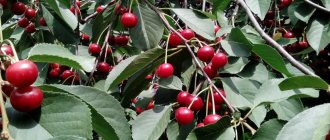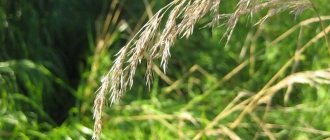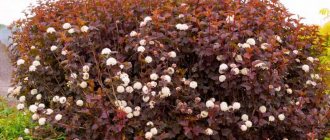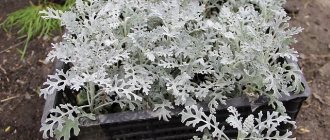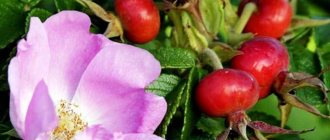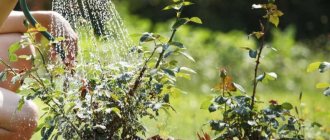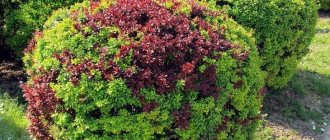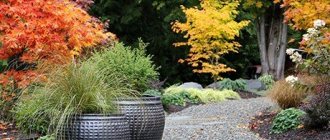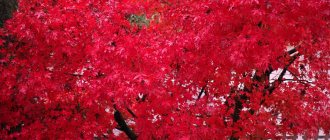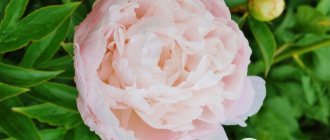It’s hard to surprise a modern gardener; such a wide variety of plants is available to decorate your favorite garden corner.
The desire to find new interesting specimens for your garden allows you to create truly unique landscape compositions.
So, limonium, or otherwise kermek, can become a bright accent in a flower group.
Description of the plant with photos of flowers
Limonium belongs to the Svinchatkov family and has about 300 varieties . Among flower growers, the bush has several names, the most famous of which are:
- static;
- sea lavender;
- swamp rosemary.
Among limoniums there are both biennial and perennial specimens . Plant sizes can range from 0.8 to 2 meters.
Most common petal color:
- white;
- Navy blue;
- yellow;
- lilac;
- lilac.
Limonium can be a herbaceous or shrubby plant (the shrub form is much less common).
Simple leaf plates are collected in a basal rosette, and small flowers form a dense spike. From such spikelets a voluminous paniculate spherical inflorescence is collected.
The natural habitat of the plant is considered to be the Mediterranean and Central Asia regions, but today limonium is distributed throughout the world . It is successfully grown even in Siberia and Altai.
Despite the diversity of Kermek species, no more than 30 varieties are used for cultural cultivation.
Interesting! The most common variety of Kermek - Limonium Tatarian - was allocated to a separate genus Goniolimon.
Types and varieties
When grown in our climate, all varieties of Kermek are conventionally divided into two large groups :
- annuals (since biennial plants are grown as annuals);
- perennial.
Limonium Bonduelli
A showy plant with bright yellow inflorescences, grown as an annual. The height of the flower is slightly more than half a meter. Limonium Bonduelli prefers open, well-lit areas.
When dried, Kermek flowers do not lose their decorative qualities and do not require additional coloring of the petals, for which they are highly valued when making compositions from dried flowers.
Limonium notched
An annual variety of Tatar kermek with bright, rich cornflower blue petals of small flowers.
The height of the plant can freely reach 0.8 m, which allows the flower to be used as a background for shorter plants.
Limonium Gmelin
Compact perennial plant with small stem height (up to 40 cm).
Dense bright green leaves form a rosette at the basal part of the plant, and the stems are topped with corymbose inflorescences consisting of small soft violet and lilac flowers.
Kermek Caspian
It belongs to the heat-loving varieties and is grown as an annual.
It has well-branched shoots and small, pale purple flowers that do not lose color intensity when dry.
Limonium chinensis
This perennial plant with fairly tall peduncles (up to 0.7 m) in our climate is often grown as an annual.
The color of the small flowers is remarkable - bright yellow with white perianth.
Chinese limonium served as a material for the creation of many decorative varieties used in the design of gardens and parks.
Common Kermek
Perennial with stems about half a meter high. It is noteworthy that the root of ordinary limonium can be 2 times the length of the peduncle.
Small purple flowers are collected in an inflorescence that resembles a panicle.
Limonium Perez
The plant comes from the Canary Islands, where it has been successfully cultivated for a long time.
The size of the bush is small - only 0.6 meters, but the tops are crowned with large inflorescences collected from small purple flowers.
Limonium Suvorov (dried flower)
It is also known as Suvorov's plantain flower, since its inflorescences most closely resemble plantain flower stalks, only they have a bright lilac or pink color.
It is grown as an annual plant.
Kermek Tatar
An unpretentious compact round plant, whose height barely reaches 0.4 m. The color of small flowers is white. After flowering ends, the stem separates from the rhizome and travels like a tumbleweed.
Kermek broadleaf
Endemic to the Caucasus Mountains, it prefers dry rocky slopes for growth. When flowering, it emits a rather unpleasant odor, which makes its cultivation problematic.
But when designing plots, landscape designers often use broadleaf limonium as a tapeworm (from the Latin solitarius - “lonely”, i.e. a separate plant).
Among the variety of cultivated varieties, gardeners are very fond of both single-color varieties (roseum, iceberg, Foreve Gold) and mixes (Foreve Mix, Petit Bouquet).
What does broadleaf kermek look like?
Description of broad-leaved or flat-leaved kermek (Limonium platyphyllum Lincz.): belongs to the Plumbaginaceae family.
This is a perennial herbaceous plant 40-100 cm high. The shoots are pubescent. The stem is straight, highly branched at the top.
All leaves are basal, simple, oblong-elliptic or oval up to 30 cm long, gradually narrowed into a long petiole, like the stem, densely pubescent with small tufted hairs, the edge is smooth, the base is wedge-shaped, the apex is notched or rounded, obtuse or truncated, leaf arrangement is regular.
As can be seen in the photo, the inflorescence of the Kermek plant is very large, loosely paniculate, almost spherical, consisting of 1-2-flowered spikelets arranged:
The bracts are broadly membranous. Flowers are 5-membered. Cup with white edge. The corolla is violet or lilac with shades of blue or light blue. The fruit is an achene, wrapped in a calyx, brown in color. Blooms in July. Fruits in August.
Distribution: grows on forest edges in dry rocky places in central Russia. In the south it grows in single individuals or small groups in the steppes, meadows, and river valleys. Less common on dry rocky slopes.
Look what the broadleaf kermek looks like in these photos:
Cultivation: propagated by sowing seeds to a permanent place before winter. Seedlings bloom in 2-3 years. If necessary, it is possible to transplant young plants under the age of 3 years, but Kermek does not tolerate late transplants well and gets very sick. The distance between plants should be 30-40 cm. Loves sunny places with drained sandy or rocky soils. Tolerates light soil salinity. Drought resistant.
Growing from seeds
Limonium is not a very demanding plant, but it does not like transplanting too much . Therefore, many gardeners practice planting seeds immediately in the ground, after the threat of return frosts has passed.
Sowing seeds
To obtain more uniform shoots and earlier flowering, Kermek seeds are sown on seedlings.
Attention! The seeds have a low germination rate (about 30%). This is also why planting seeds in open ground without prior germination is considered ineffective.
To grow seedlings, sowing is carried out in March. Individual pots are used for planting, since Kermek does not respond well to transplantation due to its long taproot.
Seedling care
Separate containers for planting should be equipped with drainage holes to remove excess moisture. Fill the pots with a light sand-peat mixture .
It is recommended to soak the seeds for a day in warm water before planting.
To plant, the seeds do not need to be buried; they are laid out on the surface of the substrate, sprinkled with a little sand.
Keep the plantings in a warm, well-lit place. After about 14 days, shoots appear .
Caring for seedlings is not difficult; for active growth it is necessary to maintain a constant temperature and ensure that the sprouts receive enough sunlight. Water the seedlings as needed.
Important! It happens that limonium gains color even at the seedling stage. So that the flower does not waste its energy in vain and produces lush flowering after transplanting into the ground, it is recommended to remove the flower stalks on the sprouts before planting them in the flowerbed.
Requirements for planting site and soil
Growing statice is not difficult; the flower does not have high requirements. Plants prefer sunny places and do not develop well in full shade, where they do not bloom so profusely. Grows in almost any garden soil. But they will look most beautiful on soils close to those where the species grows in nature. The plant should be planted in ventilated places, as it is susceptible to fungal diseases.
The soil for growing statice must be:
- not too wet;
- permeable;
- sandy loam, sandy-loamy;
- rich in lime.
Statice grows best in humus soil enriched with compost. It reacts poorly to nitrogen compounds, which cause poor flowering and make subsequent drying of the shoots difficult, so it is better not to use nitrogen fertilizers.
Static also does not like excess moisture. On heavy, wet soils it is easily affected by fungal diseases.
Planting and care in open ground
Limonium is an unpretentious plant . The gardener’s task is only to monitor the condition of the soil and the absence of parasites.
Boarding time
The optimal time for transplanting Kermek sprouts into the ground will be mid-May . At this time, the threat of return night frosts had already passed, and the soil had warmed up sufficiently.
How to plant
Limonium seedlings are planted strictly with an earthen ball using the transshipment method . With this planting, the risk of damaging the long rhizome is minimized.
The holes for planting are prepared in advance, maintaining a distance of at least 25 cm between them. Their size should be such as to completely accommodate a lump of earth from an individual pot.
After the seedlings are planted, they are watered with salted water (the solution is prepared in the proportion of 30 g of salt per 10 liters of water).
Location and lighting
Of course, limonium will feel good in an open, well-lit area, but it is so unpretentious that it will tolerate light shading without problems .
Temperature, humidity, watering
After Kermek seedlings are planted in the ground and take root, the flower requires practically no attention.
does not need additional watering if there is regular rainfall . But in hot, dry weather, Kermek still needs to be watered from time to time.
The flower does not need spraying; watering is best done in the evening at the root, avoiding moisture on the leaf blades.
Priming
It is optimal to grow limonium on loamy or sandy soils , but the plant also develops well on heavier soils.
It is better to select neutral or slightly acidic substrates for planting seedlings.
Top dressing
Kermek does not need regular fertilizing, but to maintain abundant flowering, you can use a solution of complex mineral fertilizers , which is applied every two weeks along with watering.
Flowering and wintering
Perennial varieties do not bloom in the first year after planting . The reason for this lies in the long taproot. Until the plant completely forms a root, flowering will not occur.
Flowering of annuals lasts almost the entire summer. Often limonium, having begun to bloom in June, does not shed its buds until frost.
But to preserve the decorative qualities of the inflorescences, they are cut off much earlier . Cuttings are used to create dried flower arrangements.
Annuals are dug up and burned in the fall, since leaving them for next year is pointless.
Perennial varieties overwinter well in open ground, without requiring digging.
Preparation required for wintering:
- stems are cut at ground level;
- the soil around is generously mulched with hay or covered with spruce branches;
- In the spring, you need to remove the cover to prevent moisture from accumulating at the root location.
Application in landscape design, floristry
Statice flowers dry well, their color remains unchanged for many months or even years, so they are a very desirable element in many dry and autumn bouquets.
When to collect statice for dry bouquets? Flowers are harvested when the last flower on the shoot has developed and is fully colored.
It is best to dry statice, tied in loose bunches, with the flowers facing down. The collected plants are tied in loose clusters and dried, upside down, hanging, in a spacious, shaded place.
Statice is suitable not only for drying, but also as an element of bouquet flower arrangements. They remain fresh in a vase for up to 2 weeks. To prolong freshness, you can add either ready-made mixtures or half a teaspoon of sugar per liter of water. It is necessary to change the water every day, cutting off the ends of the shoots.
The flower is also used as a flower bed plant with a long flowering period. Statice are widely used as ornamental plants. They can be planted in gardens as single specimens or in large groups. They tolerate the company of other plants well, although due to their unpretentious growing conditions, it is best to place them next to perennials. They can be used to create flower beds of the same type and multi-species, that is, mixed flower beds.
It is worth choosing plants with a similar flowering period, which will at the same time decorate the garden with decorative inflorescences and leaves. Thanks to its origin, it is the ideal solution for all gardens where Mediterranean plants are grown.
Transplantation and propagation
Kermek is propagated mainly by seeds through seedlings . This is primarily due to the fact that during the rather short Russian summer, the seeds simply do not have time to ripen and the plant does not have the opportunity to reproduce by self-sowing.
Vegetative methods (root division and cuttings) are also not successful due to the structural features of the root.
Since it has a rod shape, it is almost impossible to divide it without fatal consequences. Cuttings also do not give 100% results.
Therefore, new specimens are grown by growing seedlings from purchased seeds.
Transfer
Schisandra has a negative attitude towards transplantation . It is very difficult to preserve the root without damage. Therefore, perennial bushes are moved only if absolutely necessary. The work is carried out using the transshipment method.
To successfully remove kermek from the ground, you need to dig out the entire root without damage. Therefore, they draw a circle with a diameter of about half a meter and deepen it to a depth of a meter. Only removing the entire earthen coma will be the key to successfully moving the plant to a new location.
Sowing statice for seedlings, selecting and preparing seeds
You can collect the landing shift yourself; this should be done in the middle of summer. The fruits must ripen well. The germination rate of such planting material will be only 30%. Whereas purchased seeds have almost 100% germination.
After this, an epin solution is prepared (2 drops per 100 ml of water), in which the seeds are soaked for at least 4 hours. If you don’t have Epin at hand, you can place the treated planting material in a container with wet sawdust. Duration of aging – 2 days.
Soil selection and preparation
For Kermek seedlings, loose soil is best suited; you can make it yourself, be sure to add sand, or purchase a mixture for seedlings in the store. Purchased ready-made soil already contains useful substances that are necessary for the full development of the plant.
To prepare the soil yourself you need:
- Gain land.
- Mix soil with sand.
- Then clear the resulting mixture from stones and branches. To do this you need to sift the soil.
- Now the soil needs to be placed in an oven heated to 100 degrees and kept there for two hours.
- After this, the soil should be disinfected. This can be done by spilling the soil with a weak solution of potassium permanganate.
Before planting, the prepared soil must be watered with warm water.
Selection of capacity
You can plant statice in containers, peat or disposable cups, and flower pots. Before planting seeds, the dishes are also treated with a solution of potassium permanganate.
Direct sowing
Before planting the seeds, the soil should be watered with warm water. Place one seed at a time on the surface of the soil and sprinkle it with a thin layer of soil and again moisten it a little. After this, the containers with seeds are covered with glass or transparent film (thus creating a greenhouse effect) and placed on the windowsill. The soil needs to be watered regularly after planting.
If mold suddenly appears on the soil, you need to spill the soil with a solution of potassium permanganate and move the containers to a sunnier place
Favorable temperature for seedlings is 18-22 degrees, air humidity 60%. It is also recommended to warm the soil with seeds for 4 hours a day with a 60 W fluorescent lamp.
If all necessary conditions are met, the first shoots will appear 1-2 weeks after planting. If there is a lack of light, sprouts will appear a week later (after 3 weeks).
Rules for picking Statica
As soon as the first leaves appear on the sprouts, they can be picked. Later, you should not replant, as the tap root becomes long and can be easily damaged.
To make the procedure easy and painless for the plant, you need to make the soil as soft as possible. To do this, the seedlings must be watered two hours before picking.
A new container should be filled with soil (a 50/50 mixture of peat and sand), make a notch in the middle and carefully transfer the plant there along with the root system. If the stem of the seedling is tall enough, you can make a support from an ordinary stick.
After picking, the kermek should be placed in the sunniest area
Diseases and pests
Limonium is incredibly resistant to pest attacks and disease .
If the plant was successfully grown to the stage of transplanting into the ground, then nothing threatens the kermek further, provided that the watering regime is followed.
The most common ailment of limonium is rot , which develops due to the accumulation of moisture in the soil.
Medicinal properties
In folk medicine, kermek is widely used for the manufacture of medicines . The root of the flower has the greatest value, while the buds themselves are used only in a few collections.
Kermek root: beneficial properties
Gmelin's limonium root has medicinal . It includes:
- flavonoids;
- tannins;
- glucose;
- organic acids.
To make medicines, the root is dug up after flowering, cleaned, crushed and dried .
Based on the powder, both water and alcohol infusions are prepared. The range of applications for infusions is incredibly wide.
Contraindications to the use of Kermek
It is not recommended to take medicines based on Kermek root:
- during pregnancy and lactation;
- for children under 12 years of age;
- increased blood viscosity;
- chronic constipation.
Application of Kermek
Limonium is used for the following diseases:
- inflammatory processes in the mouth and throat;
- gastrointestinal diseases;
- malaria;
- high stomach acidity;
- internal bleeding.
Read about other plants for garden plots:
Ornithogalum: bright “stars” for apartments and cottages
Phlox Drummond - the star of any garden
Trachelium - an interesting exotic in the garden
Arabis - delicate snowdrifts of four-petaled flowers
